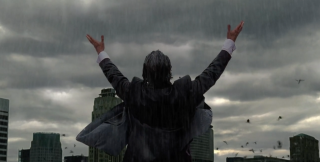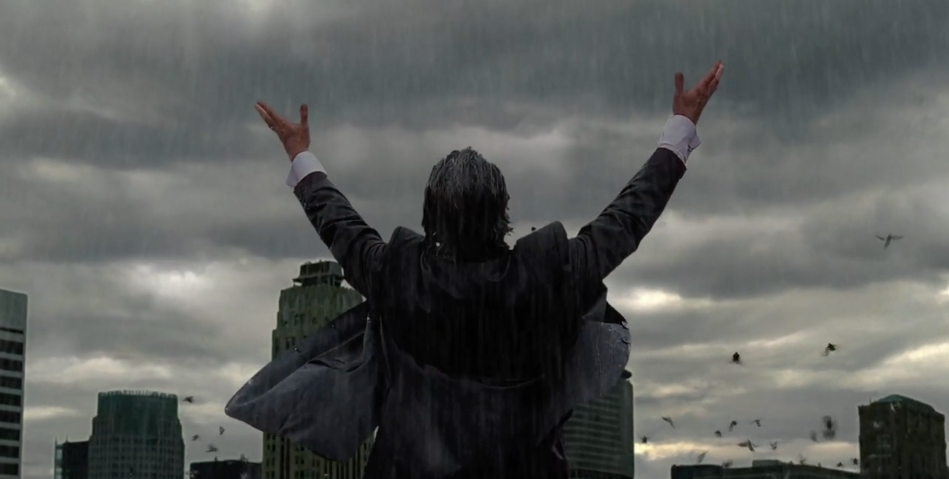The process of creating motion-picture content has not changed over the last century. It still involves four core categories: a great story, actors, crew and sets and locations.
Decades-long pipedreams of scripts seeing Hollywood daylight often come to a mortal end due to production companies dealing with cash-strapped budgets. George Bloom, an executive producer at CBS Digital, says, “Every year, 50,000 people graduate from film school. Approximately 100,000 movie scripts are floating around Hollywood trying to get sold. Last year, theatrically, there was less than 700 movies that got made,” Bloom says. “The opportunities of getting your picture made is very, very low.”
Bloom says one of the biggest obstacles to sharing your story on screen is acquiring a budget—a sizable portion of which is swallowed by securing sets and locations. To help save producers money, Bloom and his CBS Digital crew have laser-scanned endless locations over the years with thousands of hi-res images to capture the perfect geometry of a site. They’ve built fully functional, 3D, 360-degree virtual sets—all of which import into virtual reality.
“CBS [Digital] is definitely planting a flag in the [virtual reality] space,” Bloom told [a]listdaily. “How deep it’s going to go? I don’t know.”
Bloom leads a visual effects team at CBS Digital that creates content for various shows, studios and networks. He said this accounts to about 40 percent of the core business for the network. Some of the shows are already asking to test out VR experiences as well.
A lot of Bloom’s business revolves around creating visual effects and virtual sets for shows like The Last Man on Earth, Transparent, Modern Family and Netflix original shows like Daredevil and Jessica Jones. Another recent campaign included Rihanna’s Super Bowl 50 promo.
Bloom says CBS Digital is also working on building out “spatial dynamic fusion,” which blends moving lidar and video together for real-time captures so that real actors can be imbedded in a 3D environment. He says they’re at “third base” with this.
In order to capitalize on the virtual reality market, Bloom notes that one must stay ahead of the curve. He brings up the Gold Rush as a classic example—the ones who really struck gold were those selling picks and shovels.
A former vice president of creative content at Disney and Pixar Studios, and the vice president of special ops at 20th Century Fox Film Studios, Bloom’s portfolio includes producing original animation for movies like Toy Story 3, Ice Age 2, Cars 2, Ratatouille, Tangled, Alice in Wonderland and X-Men: The Last Stand, among others.
The avid astrophotographer joined [a]listdaily to share his thoughts on how the wild west known as the metaverse could perhaps soon mirror California of the 1850s.
How did you end up working in virtual reality?
I started as a director for about 17 years. It started with music videos. I directed television commercials. I had a turning point in my career where I actually sold a movie script (The Savior) to the Weinstein Studio, and was about to direct it. Then I had the opportunity to become a studio executive at Walt Disney Pictures as the vice president of creative content in the marketing division for theatrical. I decided to pass on directing a movie and to step in and climb a new mountain and work within the ecosystem of a studio. I knew that if I wanted to be well-rounded as an individual in content, I needed to understand the other side.
At CBS Digital, we’re always focusing on what we can create that’s very innovative and disruptive. We worked on a platform called Parallax—which is creating virtual sets for television shows. One of the biggest expenses is having to go out on location, for filmmakers, and storytellers. We created a virtual set by laser-scanning locations. We realized as Oculus was starting to come out with [their] new product, that this was going to work well for virtual reality. As I started to really look under the hood, I realized that VR was going to be the next place for us. It was a good match doing virtual sets. That’s kind of how it started. It was a migration.
How does the laser-scanning process work?
One of the keys to building a virtual set is you need to laser-scan the location. The laser-scanner actually creates an exact replica—a geometric, 3D model—that you’re actually able to replicate the location. From there, you put still photography on top of the geometry to build a fully functional, 3D set.
How can developers deliver compelling content for movies?
Some of it is theory. Some of it I know will work. It’s just the time to build some of the structure out of the virtual story engine. If you’re looking at the movie business, it’s a three-act structure: a beginning, a middle and an end. But I believe because of virtual reality, there’s going to be a whole new language that’s going to come out. You’re going to be able to take the stories into whole different directions. You’re going to have more interactivity. We’re really just at the beginning of a whole new era of how to communicate on film, and be able to communicate something in VR and take the audience on a new adventure they haven’t experienced before. By having virtual sets, you’re allowing someone to work in a 3D, 360 [degree] environment. When I speak about ‘Hollywood in a box,’ that old model of filmmaking where you need the big crews, you need to have all that expense . . . you’re going to be able to kind of do it in your own living room—a couple of computers, a small crew, creating content. It’s a little similar to the YouTube model, but you have to think of it in 3D space, and storylines aren’t going to have such a linear fashion.
How will virtual reality change the theater and at-home, TV-viewing experience? What are the challenges of marketing to viewers?
How is the viewer going to enjoy content in VR? It’s still to be determined. It’s the $64,000 question. How do we communicate in that space, and create something that’s compelling? Because right now, a lot of things are just an experience. So now, we’re stepping into the next space where with three-axis tracking hardware you’re actually going to be able to walk in that environment. With the hand controllers, you’re going to be able to touch the environment. The more connective you create the experience, as a story maker, you’re going to make something deeper and compelling. The audience is going to have to participate with that experience. I think you’re going to see a hybrid with passive and interactive (experiences) where you’re going to have to make some of the decisions on your own to make that story work. There is a lot of discovery that has to happen. But what you want to do is create something that’s only going to work in virtual reality. If you make something and say ‘let’s dub this movie and put it in a VR viewer’ you’re ruining it. You want to create something that’s so compelling that has to be experienced in VR, and I think that’s where a lot of people are headed. That’s why it’s such an exciting space . . . It’s the wild west. People still don’t have a language. It’s just being established now.

How can major television networks like CBS, NBC, ABC and FOX make virtual reality adopted by the masses?
A major advantage is brand awareness. Right now, the revenue for a major television studio is advertisers. There’s a lot of people that can watch TV. There’s not a lot of people that can watch VR. So, number one, it’s the monetization model. Once people adopt to the space, then I think you’re going to have an ecosystem that allows revenue to occur. So once you have the revenue come in, you have to create great content. A major network like CBS has one advantage. We have great content, great characters, great stories that we’re able to draft behind . . . That’s why Disney and most studios (will eventually) make ‘Iron Man 11.’ It’s too much risk creating new awareness than it is to create something that you already have an existing I.P.
What are your concerns within the space of virtual reality?
It’s still at a level of experimentation. With spherical video, everyone has their GoPro rigs, the Jaunt, and I think it’s great for just a passive experience, but we’ll really have to work in a 3D environment to be able to interact with that environment, so I think the passive video experience is exciting, and it’s great hype but we’re all going to have to work in a medium where we head more toward the metaverse.
What opportunities does the metaverse present?
The great thing is I see big opportunities in the metaverse and virtual reality. We’ve leveled the playing field, and there’s a whole new space out there. Anybody who has some basic skills is now going to be able to create something that you can use, and kind of be the captain of their own ship and have Hollywood in a box—and that’s what I’m excited about. The next generation of young people who are going to have a voice and tell a story.
Follow Manouk Akopyan on Twitter @Manouk_Akopyan.

